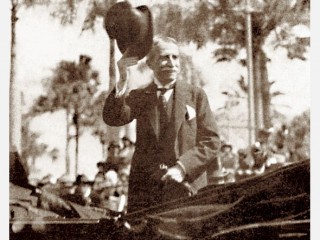
Augusto B. Leguia biography
Date of birth : 1863-02-19
Date of death : 1932-02-06
Birthplace : Lambayeque, Peru
Nationality : Peruvian
Category : Politics
Last modified : 2010-12-29
Credited as : Politician, former President od Peru,
Augusto Bernardino Leguia y Salcedo (1863-1932) was twice president of Peru. During his presidency the first industrialization of Peru began, and the country settled most of its boundary disputes with its neighbors.
Augusto Bernardino Leguia was born on Feb. 19, 1863, in Lambayeque. Educated in Valparaiso, Chile, he served in the Peruvian army during the War of the Pacific (1879-1881). After the war he was an insurance executive with the New York Life Insurance Company. By 1900 Leguia was a rich man. In 1903 he became Peru's minister of finance, serving until he resigned in 1907 to run for the presidency.
Elected, he served from Sept. 24, 1908, to Sept. 24, 1912. After leaving office Leguia was under constant attack by the new government and was finally exiled. He lived in London from 1913 to 1919, when he returned to run again for president. Having been elected, and fearing that he would not be allowed to take office, he organized a coup d'etat and became provisional president on July 4, 1919. Although a new constitution made him constitutional president, he ruled as a dictator from then until Aug. 24, 1930.
Leguia was hailed as an outstanding leader. His main contributions to Peru were threefold. First, during his years in power, most of Peru's boundary disputes with its neighbors were settled: with Brazil by a treaty in 1909, with Columbia by a treaty in 1927, and with Chile by a treaty in 1929.
Second, Leguia stimulated Peru's first industrial development. Borrowing money from New York bankers (about $90 million in the 1920s), Leguia promoted economic growth and foreign private investment by building roads, railroads, irrigation projects, and sewerage systems. He modernized the educational system, the public administration, and the armed forces. He increased the country's budget from around 50 million soles in 1919 to 141 million soles in 1931, but at the same time the national debt rose from about $40 million (U.S.) on Dec. 31, 1919, to about $146 million on June 30, 1929.
The economic development of Peru during Leguia's dictatorship benefited the country in the long run, but in the short run it caused inflation, helped to create a new oligarchy of wealth based on graft and peculation, and, because the accent upon export products forced Peru to import food for its people, caused their standard of living to be lowered.
Third, Leguia's new constitution of 1920 was the country's first to include the direct election of the president and Congress and to give the vote to all literate males over 21. But Leguia never observed the constitution, ran managed elections, censored the press, and jailed and exiled many Peruvians. By stifling all opposition, he created the climate in which Peru's first modern political party, the Peruvian Aprista party, was developed, and the activity of the Apristas through the years after Leguia's downfall pushed Peru into the modern world.
As a result of the world depression, the loans from Wall Street ceased, and Leguia was overthrown by a military coup d'etat on Aug. 24, 1930. Arrested by the victorious military officers, he eventually was put in the Lima penitentiary, where he became sick and died on Feb. 6, 1932, as a prisoner in the Naval Hospital of Bellavista.
There is no biography of Leguia. Background information is in Frederick B. Pike, The Modern History of Peru (1967); Carlos A. Astiz, Pressure Groups and Power Elites in Peruvian Politics (1969); and Sir Robert Marett, Peru (1969).
















